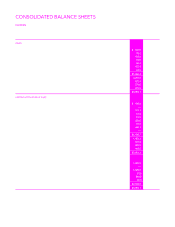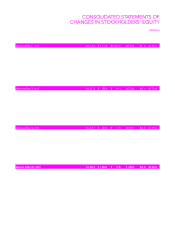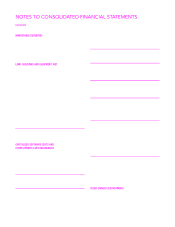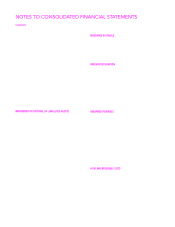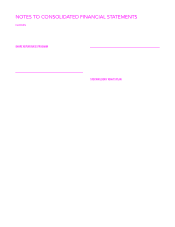Red Lobster 2015 Annual Report Download - page 42
Download and view the complete annual report
Please find page 42 of the 2015 Red Lobster annual report below. You can navigate through the pages in the report by either clicking on the pages listed below, or by using the keyword search tool below to find specific information within the annual report.
38
NOTES TO CONSOLIDATED FINANCIAL STATEMENTS
DARDEN
During the third quarter of fiscal 2015, we divested all of our interest in
our lobster aquaculture activities and we have no further commitments or
obligations with respect to such activities. This divestiture did not represent a
strategic shift in our operations, and, accordingly, it did not meet the definition
to be reported as a discontinued operation.
NOTE 3
RECEIVABLES, NET
Receivables from the sale of gift cards in national retail outlets, allowances
due from landlords based on lease terms, miscellaneous receivables and our
overall allowance for doubtful accounts are as follows:
(in millions)
May 31, 2015 May 25, 2014
Retail outlet gift card sales $47.1 $39.6
Landlord allowances due 12.9 22.5
Miscellaneous 18.9 22.0
Allowance for doubtful accounts (0.9) (0.3)
Receivables, net $78.0 $83.8
NOTE 4
IMPAIRMENTS AND DISPOSAL OF ASSETS, NET
During fiscal 2015, 2014 and 2013, we recognized net long-lived asset
impairment and disposal charges of $62.1 million ($40.3 million net of tax),
$16.4 million ($10.1 million net of tax) and $0.9 million ($0.6 million net of
tax), respectively. During fiscal 2015, management identified nine Olive Garden
locations and three Seasons 52 locations where the estimated useful life was
significantly shortened based on a re-evaluation of expected lease renewals,
leading to significant decreases in projected cash flows. Of the total impair-
ments in fiscal 2015, $34.1 million related to these restaurant impairments. In
addition, during fiscal 2015 we began marketing selected restaurant assets
for individual sale leasebacks. During fiscal 2015, we recorded impairment
charges of $15.2 million related to the restaurant assets involved in sale-
leaseback arrangements which either closed in fiscal 2015 or are expected
to close in fiscal 2016. Impairment charges were measured based on the
amount by which the carrying amount of these assets exceeded their fair
value. Fair value is generally determined based on appraisals or sales prices
of comparable assets and estimates of future cash flows. We also recognized
impairments of assets related to the expected disposal of excess land parcels,
our lobster aquaculture project and a corporate airplane in connection with
the closure of our aviation department during fiscal 2015. These costs are
included in impairments and disposal of assets, net as a component of
earnings from continuing operations in the accompanying consolidated
statements of earnings for fiscal 2015, 2014 and 2013.
NOTE 5
LAND, BUILDINGS AND EQUIPMENT, NET
The components of land, buildings and equipment, net, are as follows:
(in millions)
May 31, 2015 May 25, 2014
Land $ 633.5 $ 659.7
Buildings 3,338.9 3,234.5
Equipment 1,439.1 1,378.4
Assets under capital leases 72.0 69.5
Construction in progress 36.9 89.1
Total land, buildings and equipment $ 5,520.4 $ 5,431.2
Less accumulated depreciation
and amortization (2,277.7) (2,027.0)
Less amortization associated with
assets under capital leases (26.9) (23.2)
Land, buildings and equipment, net $ 3,215.8 $ 3,381.0
During fiscal 2015, we announced a plan to pursue sale-leaseback
transactions of approximately 75 restaurant properties and our corporate
headquarters. Of the 75 properties listed for sale-leaseback transactions,
14 were completed during fiscal 2015 generating proceeds of $44.9 million,
resulting in a deferred gain of $6.7 million which will be amortized over the
leaseback period on a straight-line basis. Subsequent to our fiscal 2015 year
end, we completed an additional 15 individual restaurant sale-leaseback
transactions, generating proceeds of approximately $63.6 million. We expect
to complete the remainder of the sale-leaseback transactions during fiscal 2016.
NOTE 6
SEGMENT INFORMATION
We manage our restaurant brands, Olive Garden, LongHorn Steakhouse, The
Capital Grille, Yard House, Bahama Breeze, Seasons 52 and Eddie V’s in North
America as operating segments. The brands operate principally in the U.S.
within full-service dining. We aggregate our operating segments into reportable
segments based on a combination of the size, economic characteristics and
sub-segment of full-service dining within which each brand operates. We have
four reportable segments: 1) Olive Garden, 2) LongHorn Steakhouse, 3) Fine
Dining and 4) Other Business. Prior to fiscal 2015, we aggregated all of our
operating segments into one reportable segment. However, we believe
disaggregating our one segment into these four reportable segments
provides more beneficial information for our financial statement users.
The Olive Garden segment includes the results of our company-owned
Olive Garden restaurants in the U.S. and Canada. The LongHorn Steakhouse
segment includes the results of our company-owned LongHorn Steakhouse
restaurants in the U.S. The Fine Dining segment aggregates our premium
brands that operate within the fine-dining sub-segment of full-service dining
and includes the results of our company-owned The Capital Grille and Eddie
V’s restaurants in the U.S. The Other Business segment aggregates our
remaining brands and includes the results of our company-owned Yard House,
Seasons 52 and Bahama Breeze restaurants in the U.S. This segment also
includes results from our franchises and consumer-packaged goods sales.
External sales are derived principally from food and beverage sales, we
do not rely on any major customers as a source of sales and the customers
and long-lived assets of our reportable segments are predominantly in the
U.S. There were no material transactions among reportable segments.


